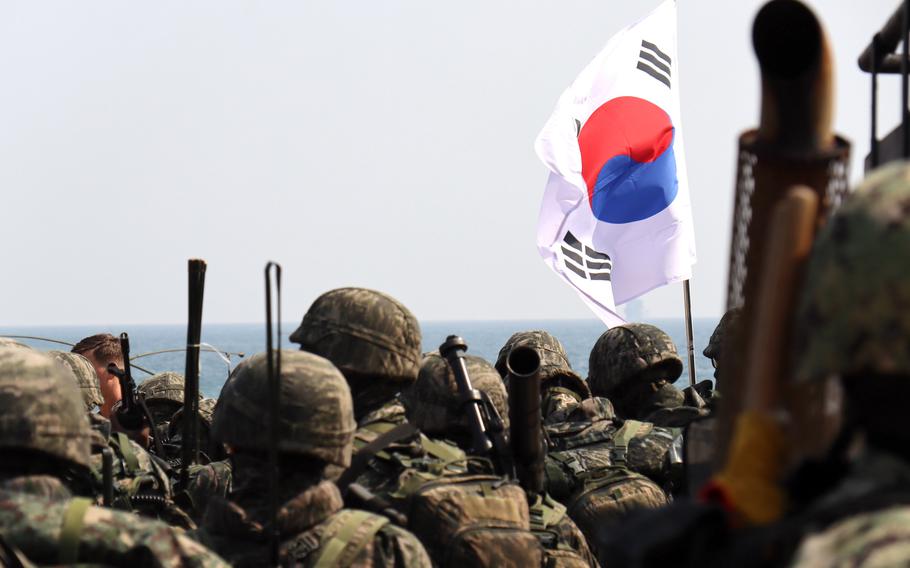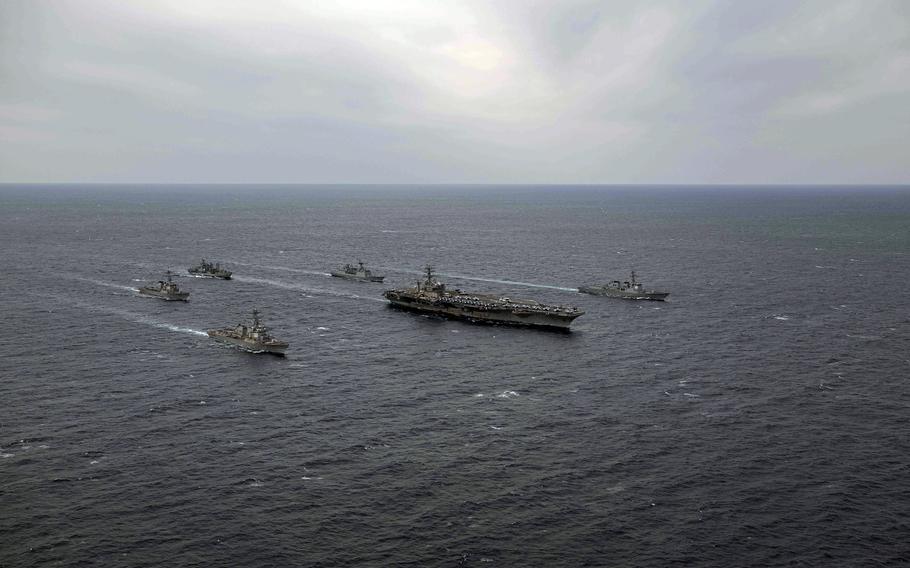
South Korean marines stand in formation during the Ssangyong exercise in Pohang, South Korea, March 29, 2023. (David Choi/Stars and Stripes)
CAMP HUMPHREYS, South Korea — Japan joined the U.S. and South Korea for a two-day naval drill on Monday, another in a series of large military exercises on the peninsula, the most recent involving a visiting U.S. aircraft carrier.
The drills on land, in the air and at sea are the largest involving the U.S. and South Korea in five years. They included live-fire drills by the U.S. Army and its South Korean partners, flyovers by fighters and bombers and amphibious landings by South Korean and U.S. Marines.
Antisubmarine and search-and-rescue drills that began Monday near the South Korean island of Jeju will improve “troops’ reaction capabilities against advancing North Korean submarine capabilities and nuclear and missile threats,” according to a news release from the South’s Ministry of National Defense.
“We will overwhelmingly and decisively respond to any forms of North Korean provocation and thus incapacitate them,” South Korean Rear Adm. Kim Inho said in the release.
For the first time in seven years the three countries will tackle scenarios involving humanitarian assistance and maritime accidents, according to the release.

The aircraft carrier USS Nimitz sails with the destroyers USS Decatur and USS Wayne E. Meyer, along with South Korean warships, near the Korean Peninsula on March 27, 2023. (Kenneth Lagadi/U.S. Navy)
The commander of the Nimitz Carrier Strike Group, Rear Adm. Christopher Sweeney, will lead the exercise; the aircraft carrier USS Nimitz will participate along with the group’s destroyers USS Wayne E. Meyer and USS Decatur, the release said states.
South Korea sent three destroyers and a logistics vessel; Japan’s Maritime Self-Defense Force dispatched the destroyer JS Umigiri.
The three-nation drills commenced as the two-week Ssangyong exercise by the U.S. and South Korea navies concluded on Monday. The exercise consisted of roughly 5,500 troops, 30 ships and 70 aircraft from both countries and was the largest maritime exercise between them in five years.
Ssangyong included a mock amphibious landing near Pohang in the country’s south by Marines from the 13th Marine Expeditionary Unit and their South Korean counterparts.
The two allies simultaneously conducted Warrior Shield, a series of large-scale field exercises over 11 days that included live-fire artillery practice by the U.S. 2nd Infantry Division. Alongside that exercise, the two militaries, with U.N. Command and Combined Forces Command held Freedom Shield, a tabletop exercise to simulate their response to a North Korean attack.
The U.S. and South Korean commands say their exercises are defensive in nature; North Korea’s state-run media describes them as rehearsals for an invasion of their country.
The naval drills this week will focus on detecting underwater threats from North Korea, according to the ministry’s release.
On March 12, Pyongyang fired what the state-run Korean Central News Agency described as cruise missiles from a submarine. Nine days later, KCNA reported that North Korea tested an “underwater nuclear attack drone” that could create a “radioactive tsunami.”
South Korea’s Joint Chiefs of Staff on March 27 described the North’s claims as “exaggerated and fabricated.”
North Korea repeatedly warned that the drills fueled tensions in the region and that it considered them acts of war.
The communist regime fired 11 ballistic missiles in eight separate days of testing so far this year. It last fired two short-range ballistic missiles that flew toward the Sea of Japan, also known as the East Sea, on March 27.